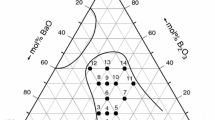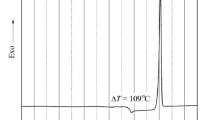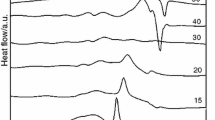Abstract
Glasses in the PbO–ZnO–B2O3system with a lead oxide content of less than 65 mol % are studied. The glass formation region for these glasses is determined. Their crystallization ability, density, and moisture resistance and the thermal, optical, and electrical properties are investigated. The composition–property curves are constructed. It is found that these dependences exhibit anomalies for glasses along the composition joins with constant boron oxide contents of 40 and 50 mol %. These anomalies can be associated with the change in the role of lead ions in the glass structure.
Similar content being viewed by others
REFERENCES
Dale, A.E. and Stanworth, J.E., A Note on Very Soft Glasses and Some of Their Electrical Applications, J. Soc. Glass Technol., 1948, vol. 32, pp. 147-153.
Dale, A.E. and Stanworth, J.E., The Development of Some Very Soft Glasses, J. Soc. Glass Technol., 1949, vol. 33, pp. 167-175.
Skornyakov, M.M., Low-Melting Glasses, Opt.-Mekh. Prom-st., 1957, no. 1, pp. 36-44.
Mazurin, O.V., Strel'tsina, M.V., and Shvaiko-Shvaikovskaya, T.P., Svoistva stekol i stekloobrazuyushchikh rasplavov: spravochnik (Properties of Glasses and Glass-Forming Melts: A Handbook) Leningrad: Nauka, 1979, vol. 3, part 2, pp. 114, 117, 118, 122, 125-128.
Petzoldt, J., Rontgenografische Untersuchungen in oxydsystem PbO-ZnO-B2O3, Glastech. Ber., 1966, vol. 39, pp. 130-136.
Sarkisov, P.D. and Agarkov, A.S., Tekhnicheskii analiz i kontrol’ proizvodstva stekla i izdelii iz nego (Technical Analysis and Control of Glass Manufacture and Glass Articles), Moscow: Stroiizdat, 1976.
Batsanov, S.S., Strukturnaya refraktometriya (Structural Refractometry), Moscow: Moscow Gos. Univ., 1959.
Fedorova, L.F., Sasova, I.A., Ermolaeva, A.I., and Petrova, V.Z., Luminescence Determination of the Chemical Durability of Alkali-Free Glasses, in Sbornik nauchnykh trudov po problemam mikroelektroniki (Collected Works on the Problems of Microelectronics), Moscow: MIET, 1972, issue 13, pp. 242-248.
Bray, P.J., NMR Studies of Borates, Borate Glasses: Structure, Properties, and Applications, in Vat. Sci. Res., 1977, vol. 12, no. 1, pp. 32-48.
Moore, H. and Carey, M., Limiting Compositions of Binary Glasses of the Type xR2O · SiO2 and of Ternary Glasses of Types yR2O · yR2O3 · SiO2 in Relation to Glass Structure, Trans. Soc. Glass Technol., 1951, vol. 35, no. 162, pp. 43-57.
Naray-Szabo, I. and Kalman, A., Die Struktur des K2Pb2Si2O7 und der Bleiglaser, Silikattechnik, 1961, vol. 12, pp. 316-318.
Obshchaya khimiya v formulakh, opredeleniyakh, skhemakh (The General Chemistry in Formulas, Definitions, and Schemes), Tikavoi, V.F., Ed., Minsk: Izd. Universitetskoe, 1987.
Mashkovich, M.D., Elektricheskie svoistva neorganicheskikh dielektrikov v diapazone SVCh (Electrical Properties of Inorganic Dielectrics in the Microwave Range), Moscow: Sovetskoe Radio, 1969.
Author information
Authors and Affiliations
Rights and permissions
About this article
Cite this article
Ermolaeva, A.I. Glass Formation and Properties of Glasses in the PbO–ZnO–B2O3System. Glass Physics and Chemistry 27, 306–315 (2001). https://doi.org/10.1023/A:1011360025333
Issue Date:
DOI: https://doi.org/10.1023/A:1011360025333




